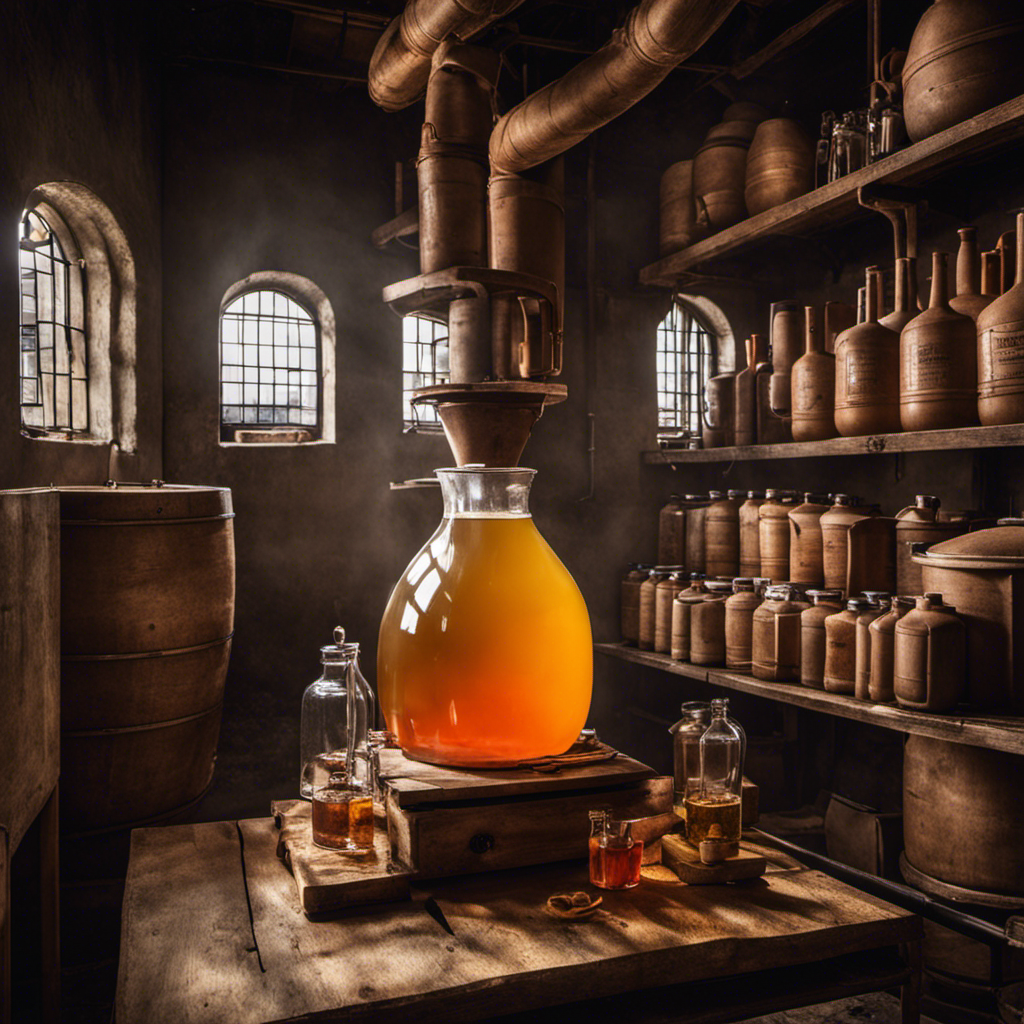I’ve always been fascinated by the resourcefulness and ingenuity that can be found in unexpected places. One such example is the curious world of toilet wine. Yes, you read that right.
Toilet wine, a beverage concocted in the most unlikely of settings, has become a topic of intrigue and curiosity. In this article, we will delve into the origins, production methods, and even the risks associated with this unique creation.
So, grab a seat and prepare to sip on some knowledge about the clandestine world of toilet wine.
Key Takeaways
- Toilet wine originated in prisons and correctional facilities as a result of restricted access to alcohol.
- Inmates use fermentation to transform simple ingredients like fruit, sugar, and yeast into alcohol.
- Toilet wine can be contaminated and produce toxic byproducts, posing health risks to inmates.
- Crafting toilet wine showcases resourcefulness, ingenuity, and resilience in the face of adversity.
The Origins of Toilet Wine
Toilet wine’s origins can be traced back to prisons and other correctional facilities. In these confined spaces, where access to alcohol is restricted or prohibited entirely, inmates have ingeniously devised methods to create their own alcoholic beverages. The development of toilet wine recipes and the cultural significance of toilet wine in certain communities are fascinating topics to explore.
Toilet wine, also known as pruno, has become a symbol of resourcefulness and defiance within these communities. It is not just about getting drunk, but about asserting autonomy and maintaining a sense of normalcy amidst a restrictive environment. Understanding the origins and cultural significance of toilet wine provides insight into the resilience and creativity of those who have crafted this unconventional libation.
Now, let’s delve into how toilet wine is made.
How Toilet Wine Is Made
You might be surprised by just how resourceful and creative inmates can get when it comes to making their own homemade alcoholic beverages.
In prison, a process known as fermentation is used to transform simple ingredients into a potent and intoxicating brew. The fermentation process begins with the selection of ingredients, which often include fruit, sugar, and yeast.
These ingredients are combined in a container, such as a plastic bag or a makeshift fermentation vessel, and left to ferment for several days or even weeks. During this time, the yeast consumes the sugar, converting it into alcohol and carbon dioxide.
The resulting liquid, often referred to as ‘toilet wine,’ can have a high alcohol content, making it a popular choice among inmates looking to escape the monotony of prison life. Despite its unappealing name, toilet wine showcases the ingenuity and creativity of those who find themselves behind bars.
The Risks and Dangers of Toilet Wine
If you’re not careful, the homemade alcoholic brew created in prison using the fermentation process can pose serious risks and dangers. Toilet wine, as it is commonly known, may seem like a harmless way for inmates to pass the time, but it comes with significant health hazards and legal consequences.
Here are some key points to consider:
-
Contamination: Toilet wine is made using unsanitary ingredients and equipment, increasing the risk of bacterial and fungal infections.
-
Toxicity: The ingredients used in toilet wine, such as fruit juice and bread, can produce harmful byproducts during fermentation, leading to serious health issues or even death.
-
Legal ramifications: Inmates caught brewing toilet wine can face additional charges and extended sentences, as possessing or consuming alcohol in prison is strictly prohibited.
-
Punishments: Disciplinary actions, such as solitary confinement or loss of privileges, may be imposed on inmates involved in the production or consumption of toilet wine.
Given the risks to health and the potential legal consequences, it is crucial for inmates to understand the dangers associated with toilet wine and seek alternative activities during their incarceration.
Prison Culture and Toilet Wine
When incarcerated, it’s important to be aware of the prison culture and the potential risks associated with homemade alcoholic brew.
In prison, a unique economy exists, one that thrives on ingenuity and resourcefulness. This economy extends to the production and distribution of alternative alcohol, commonly referred to as ‘toilet wine.’
In the absence of commercially available alcohol, inmates turn to crafting their own brew using readily accessible ingredients such as fruit, sugar, and bread. The prison economy plays a significant role in the production and distribution of toilet wine, with inmates often trading or selling their homemade concoctions for various goods and services.
However, it is crucial to understand that consuming toilet wine can have severe consequences, including health risks, disciplinary actions, and even violence within the prison community. Therefore, it is essential for inmates to weigh the potential benefits against the potential dangers before engaging in this illicit activity.
Toilet Wine as a Survivalist Skill
Crafting homemade alcohol in prison requires resourcefulness and ingenuity. Inmates rely on readily available ingredients to create their own unique brews. It is a survivalist skill honed out of necessity, an art form born within the confines of concrete walls.
Toilet wine recipes are whispered secrets, passed down from one inmate to another. They are meticulously refined and perfected over time. The process involves fermenting fruit, sugar, and water in a makeshift container, often a plastic bag hidden away in the depths of a toilet tank.
But what happens when the toilet wine is ready to be consumed? Here are some alternative uses for this forbidden elixir:
- Bartering currency within the prison economy
- Fueling underground parties and celebrations
- Providing a temporary escape from the harsh reality of prison life
- Creating a sense of camaraderie and bonding among inmates
Crafting toilet wine is not just about getting drunk; it is about survival, connection, and the resilience of the human spirit in the face of adversity.
Conclusion
In conclusion, after delving into the world of toilet wine, it is evident that this unique concoction has its roots firmly planted in the desperation of prison culture.
While the process of making toilet wine may seem crude and unsanitary, it is a testament to human ingenuity and resourcefulness.
However, it is important to note the risks and dangers associated with consuming such a beverage, as it can have detrimental effects on one’s health.
Understanding the origins and intricacies of toilet wine allows us to appreciate the resilience and creativity of individuals who have found themselves in dire circumstances.










